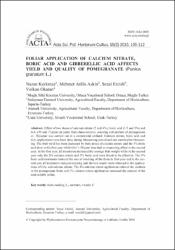| dc.contributor.author | Korkmaz, Nazan | |
| dc.contributor.author | Aşkın, Mehmet Atilla | |
| dc.contributor.author | Ercişli, Sezai | |
| dc.contributor.author | Okatan, Volkan | |
| dc.date.accessioned | 2020-11-20T15:03:52Z | |
| dc.date.available | 2020-11-20T15:03:52Z | |
| dc.date.issued | 2016 | |
| dc.identifier.issn | 1644-0692 | |
| dc.identifier.uri | https://hdl.handle.net/20.500.12809/2795 | |
| dc.description | WOS: 000381844800009 | en_US |
| dc.description.abstract | Effect of two doses of calcium nitrate (2 and 4%), boric acid (1.5 and 3%) and GA(3) (50 and 75 ppm) on yield, fruit characteristics, cracking and sunburn of pomegranate cv. Hicaznar was carried out in a commercial orchard. Calcium nitrate, boric acid and GA(3) applications have been done during blossoming period and one month after blossoming. The fruit yield has been increased by both doses of calcium nitrate and the 3% boric acid dose in the first year while GA(3)'s 50 ppm dose had an improving effect in the second year. In the first year, all treatments increased the average fruit weight while in the second year only the 2% calcium nitrate and 3% boric acid were found to be effective. The 3% boric acid treatments reduced the rate of cracking of the fruits in first year and in the second year all treatments reduced cracking and the best results were obtained in the applications of GA(3) and calcium nitrate. The 4% calcium nitrate application reduced the sunburn in the pomegranate fruits and 2% calcium nitrate application increased the amount of the total soluble solids. | en_US |
| dc.description.abstract | Streszczenie. W komercyjnym sadzie badano wpływ dwóch dawek azotanu wapnia (2 i 4%), kwasu borowego (1,5 i 3%) i kwasu giberelinowego (50 i 75 ppm) na plon, cechy owoców, pękanie i poparzenia słoneczne granatu odmiany Hicaznar. Azotan wapnia, kwas borowego oraz GA3 zastosowano podczas kwitnienia i miesiąc po kwitnieniu. Plon owoców wzrósł przy obydwu dawkach azotanu wapnia i kwasu borowego w pierwszym
roku, a dawka GA3 50 ppm miała pozytywny wpływ w drugim roku. W pierwszym roku wszystkie zabiegi podnosiły średnią masę owoców, natomiast w drugim roku tylko 2% azotan wapnia i 3% kwas borowy okazały się skuteczne. Zabiegi 3% kwasem borowym zmniejszały pękanie owoców w pierwszym roku, a w drugim roku wszystkie zabiegizmniejszały pękanie, natomiast najlepsze rezultaty osiągnięto po zastosowaniu GA3 i azotanu
wapnia. Zastosowanie 4% azotanu wapnia zmniejszało poparzenie słoneczne owoców granatu, a zastosowanie 2% azotanu wapnia zwiększało całkowitą ilość rozpuszczalnychzwiązków stałych. | |
| dc.description.sponsorship | Suleyman Demirel University Department of Scientific Research Projects [32.53.D212] | en_US |
| dc.description.sponsorship | This research was supported by the Suleyman Demirel University Department of Scientific Research Projects, Project No. 32.53.D212. | en_US |
| dc.item-language.iso | eng | en_US |
| dc.publisher | Wydawnictwo Akad Rolniczej W Lublinie | en_US |
| dc.item-rights | info:eu-repo/semantics/openAccess | en_US |
| dc.subject | Fruit Cracking | en_US |
| dc.subject | L. | en_US |
| dc.subject | Sunburn | en_US |
| dc.subject | Vitamin C | en_US |
| dc.title | FOLIAR APPLICATION OF CALCIUM NITRATE, BORIC ACID AND GIBBERELLIC ACID AFFECTS YIELD AND QUALITY OF POMEGRANATE (Punica granatum L.) | en_US |
| dc.item-title.alternative | WPŁYW DOLISTNEGO ZASTOSOWANIA AZOTANU WAPNIA,KWASU BOROWEGO I KWASU GIBERELINOWEGO NA PLONI JAKOŚĆ GRANATU | |
| dc.item-type | article | en_US |
| dc.contributor.department | MÜ, Ortaca Meslek Yüksekokulu, Bitkisel Ve Hayvansal Üretim Bölümü | en_US |
| dc.contributor.institutionauthor | Korkmaz, Nazan | |
| dc.identifier.volume | 15 | en_US |
| dc.identifier.issue | 3 | en_US |
| dc.identifier.startpage | 105 | en_US |
| dc.identifier.endpage | 112 | en_US |
| dc.relation.journal | Acta Scientiarum Polonorum-Hortorum Cultus | en_US |
| dc.relation.publicationcategory | Makale - Uluslararası Hakemli Dergi - Kurum Öğretim Elemanı | en_US |


















